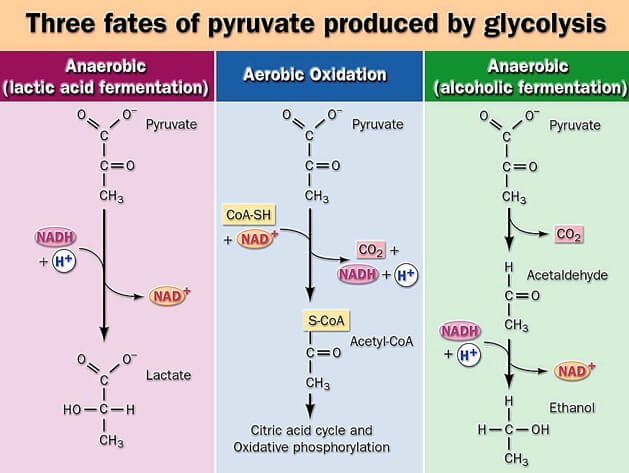Table of Contents
Pyruvate is a component of the process of lactic acid and alcohol fermentation in anaerobic conditions. in an aerobic state, pyruvate loses carbon dioxide and hydrogen, and transform into Acetyl CoA and enter the TCA cycle. It can as well, enter the biosynthetic pathways. If there is a drop in levels of glucose, pyruvate goes into the gluconeogenesis process.
Fate of pyruvate in anaerobic conditions
In anaerobic conditions, pyruvate was splits into the lactic acid ferment as well as alcohol fermentation.

Pyruvate work as terminal electron acceptors in lactic acid fermentation
If tissue isn’t supplied with oxygen, or when muscle is receiving less oxygen than is needed, the pyruvate acts as an electron acceptor in NADH (formed through glycolysis) and then converted to lactate in which is a process known as the lactic acid fermentation. RBCs, retina cells and muscles in exercise and hypoxic conditions also breathe through lactic acid fermentation. In lactic acid fermentation, pyruvate receives electrons from NADH and then reduced into lactate, which restores the NAD+ to continue the cycle of the reaction.
Pyruvate + NADH → lactate + NAD
lactate dehydrogenase
Lactate that is formed in active muscles is transported to the liver, where it is broken down and then transformed to glucose. The restored glucose that is derived from lactate can be transported to muscles. This process is known as Cori cycle. Cori cycle.
Fate of Pyruvate in alcoholic fermentation
The microorganisms, including yeast, convert glucose into ethanol. The the glycolytic end product pyruvate is introduced into alcoholic fermentation. This process is an in-between reaction.
The first step is decarboxylation of pyruvate. the pyruvate transforms into acetaldehyde after loss of carbon through the action of the pyruvate decarboxylase enzyme when it is in the presence of Mg++ and TPP.
Pyruvate → Acetaldehyde + CO2
pyruvate decarboxylase
In the next step in the second step, acetaldehyde takes the electrons from NADH (formed by glycolysis) to convert it back to NAD+ in the next process, which is then converted into alcohol by the action of the alcohol dehydrogenase enzyme.
Acetaldehyde + NADH → Ethanol + NAD+
alcohol dehydrogenase
Fate of pyruvate in case of aerobic respiration
In aerobic respiration the pyruvate changes into Acetyl CoA which is then are absorbed to the TCA cycle (Krebs cycle) by an oxidative decarboxylation reaction, which is catalyzed by the pyruvate dehydrogenase complex consisting of three enzymes E1, E2, and E3. E1= pyruvate dehydrogenase, E2= dihydrolipoyl transacetelase, E3= dihydrolipoyl dehydrogenase). Complex of pyruvate dehydrogenase (E1 E2, E2 and E3) requires five coenzymes to perform this reaction. They are TPP and lipoate, CoA-SH FAD, CoA-SH, and NAD+ for catalyzing the reaction. E1 in conjunction with TPP releases CO2 from pyruvate. It also transfers active acetyl group into TPP and TPP. TPP transfers acetyl group to lipoate bonded to E2, and then lipoate transfer acetyl groups to CoA.SH creating Acetyl CoA and E3 transfers H from reduced lipoate to FAD that transfers electron to NAD+, forming NADH + H+. This Acetyl CoA can be incorporated into TCA.
Pyruvate + E1 + E2 + E3+TPP+ lipoate+CoA-SH+ FAD+ NAD+ → Acetyl CoA+ E1+E2+E3+ TPP+ lipoate+FAD+NADH+H+
Fate of pyruvate in the biosynthetic pathway
Pyruvate also has the ability to be a part of the biosynthetic pathways like the biosynthesis of fatty acids and the process of gluconeogenesis. Pyruvate transforms into the acetyl CoA through the action of pyruvate’s dehydrogenase complex . This Acetyl CoA is also incorporated in the biosynthetic process along with TCA. Pyruvate also has the potential to enter gluconeogenesis via the actions of pyruvate carboxykinase, which converts it into oxaloacetate that, with many steps of reaction transforms into glucose.
FAQ
Q1. which of the following is not a fate for pyruvate?
- the conversion to ethanol
- the conversion to lactate
- the conversion to malate
- oxidation through the citric acid cycle
Ans: The conversion to malate
Explanation:
Pyruvate is the chemical process is produced by glycoysis and can be used for a variety of purposes and could result in co-enzyme acetyl and undergo aerobic oxidation that occurs in the acid cycle. It is able to produce glucose, but it has never produced malate. In prokaryotes, it could be used as a part of the anaerobic fermentation process to produce the ethanol, which is the final product.
Q2. what is the typical fate of pyruvate in red blood cells?
Completely oxidized to CO2 and H2O.
Q3. in aerobic metabolism, what is the fate of pyruvate produced by glycolysis?
Pyruvate acts as the connection between numerous metabolic processes like cellular respiration, fermentation, biosynthesis of fatty acids and glycoconeogenesis. Pyruvate is a result of glycolysis. Pyruvate is a compound of two molecules that created by partial oxygenation of glucose. The three principal ways that pyruvate can be utilized in cells is aerobic respiration as well as lactic acid fermentation, and the alcoholic fermentation (anaerobic respiration). The pyruvate produced by aerobic respiration transported to mitochondria and undergoes an oxidative decarboxylation process to create acetyl CoA that is then incorporated into the Krebs cycle. In the process of fermentation, as the name implies alcohol and lactic acid are created.
